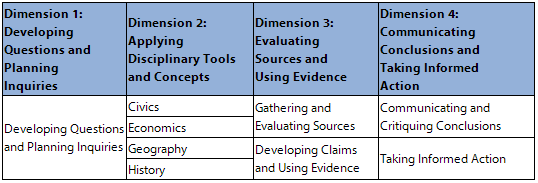When charged with creating an infographic about Teaching and Learning in the Digital Age, I was stumped as to where I should begin. I had spent the last few weeks developing a new social studies curriculum for the 7th grade and my mind was already overloaded with the C3 and the CT Social Standards. The National Council of the Social Studies issued the College, Career, and Civic Life (C3) Framework in 2013. The framework has four dimensions.

When I began reading “Multimodal Learning Through Media: What the Research Says” by the Merti Group authentic audience jumped out at me. The article states people learn best in authentic environments. The Merti group defines authentic learning by “three key concepts: depth of academic concept or deep learning, relevance to person(s) outside the classroom, and student use of the key ideas in a production.” This information matched up perfectly with Dimension 4 of the C3 Framework which endeavors to create “active and responsible citizens” who can “identify and analyze public problems; deliberate with other people about how to define and address issues; take constructive, collaborative action; reflect on their actions; create and sustain groups; and influence institutions both large and small” (NCSS 2013). Reproducing any of these actions in the classroom fits the definition of authentic learning and the key to incorporating them in the classroom is technology. Not all students can attend a march on the capital or raise money to build a well in Malawi. But all students can reach an authentic audience through the internet.
My initial topic was the incorporation of technology in the classroom to reach an authentic audience and therefore, C3 Dimension 4. I was fixated on the tech. The feedback I received on G+ and from my colleagues forced me to take a more UBD (Understanding By Design)  perspective. I became less focused on using a specific form of technology and more focused on the objective and how I could use technology to obtain my objective. Therefore, I edited several of my infographic topics to background on creating an authentic audience and linked icons to applications teacher could select from after they identified their objectives. The focus changed from blogging, vlogging, and polling to creating an authentic audience. I learned creating an infographic is a lot like creating a lesson plan. Objectives cannot be achieved unless they are set.
perspective. I became less focused on using a specific form of technology and more focused on the objective and how I could use technology to obtain my objective. Therefore, I edited several of my infographic topics to background on creating an authentic audience and linked icons to applications teacher could select from after they identified their objectives. The focus changed from blogging, vlogging, and polling to creating an authentic audience. I learned creating an infographic is a lot like creating a lesson plan. Objectives cannot be achieved unless they are set.
Please take a look at my infographic and join the conversation about UBD or creating an authentic audience by commenting below.
*Author’s note: Sources used to support to my claims are linked in the blog and on the infographic. Though this method of citation is non-traditional for academic work, it is the authentic 21st version of citation that has only become possible with the invention of technology that supports links. I image citations will go the way of the footnote and for that matter the dinosaur as technology continues to advance human capability. -kg



